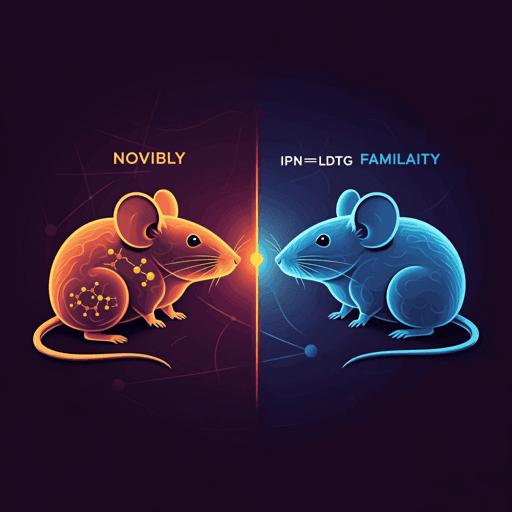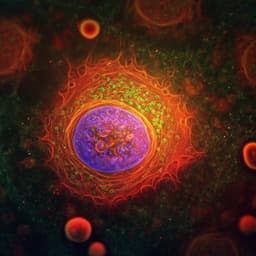
Biology
Dopamine control of social novelty preference is constrained by an interpeduncular-tegmentum circuit
S. Molas, T. G. Freels, et al.
Mice preferentially explore novel over familiar social cues through strong mesolimbic dopamine responses that control interaction bout length, while an IPN→LDTg GABAergic circuit suppresses dopamine to limit familiarity-driven interactions. Using calcium and neurotransmitter sensors with fiber photometry and optogenetics, the study maps how novelty interest is encoded and regulated. This research was conducted by Authors present in <Authors> tag.
~3 min • Beginner • English
Introduction
The study addresses how the brain encodes preference for social novelty (NP) over familiarity and the circuit mechanisms that regulate this behavior. Prior work implicates mesolimbic dopamine (DA) in social reward and prediction error signaling, yet the precise dynamics of DA activity as novel social cues become familiar, and which aspects of interaction are encoded, remain unclear. The interpeduncular nucleus (IPN) has been linked to familiarity signaling and avoidance-related behaviors. The authors hypothesize that mesolimbic DA encodes interest in social novelty, particularly the length of initial interaction bouts, and that an inhibitory IPN→laterodorsal tegmentum (LDTg) circuit dynamically modulates DA to constrain NP by promoting termination of familiar social investigations.
Literature Review
- Mesolimbic DA from VTA to ventral striatum/NAc is engaged by social cues in humans and animals and encodes reward prediction error to drive learning (refs 8–14).
- Prior work showed IPN as a substrate for familiarity signaling crucial for NP and is associated with avoidance- and aversion-related behaviors (refs 15, 21–23, 41).
- LDTg provides cholinergic, GABAergic, and glutamatergic inputs to VTA controlling DA neuron firing and reward processing; IPN inputs to LDTg can mediate aversion (refs 24–27, 41, 43–45).
- DA responses can also be engaged at termination of explorations to reinforce avoidance of threatening stimuli (ref 20).
Methodology
- Subjects: C57BL/6J, GAD2Cre, DATCre, ChATCre mice. Males primarily used for social assays; juvenile sex-matched C57BL/6J conspecifics as stimuli. Standard housing and reverse light cycle prior to testing.
- Behavioral paradigms: Three-chamber sociability/novelty and NP task over 4 days. Days 1–3: repeated exposure to same conspecific; Day 4: choice between familiar and novel conspecifics. NP ratio calculated as (novel – familiar interaction time)/total social interaction time.
- Fiber photometry: GCaMP6m expressed in VTA DA neurons of DATCre mice to record DAergic activity; dLight1.2 expressed in NAc to measure DA release. Photometry at 465/405 nm with lock-in demodulation; ΔF/F0 and z-scores computed; event-aligned analyses at onset and offset of investigations; AUC and peak metrics extracted.
- Optogenetics:
- Activation: Cre-dependent ChrimsonR in VTA DA neurons (DATCre) with closed-loop photostimulation (593–595 nm; 30 Hz, 8 ms, 5 s ON/5 s OFF in home cage; closed-loop during NP near cylinders) while recording NAc dLight.
- Inhibition: Retrograde Cre-dependent eNpHR3.0 injected in LDTg of GAD2Cre mice to silence IPN→LDTg GABAergic projections; constant 593 nm light delivered closed-loop during NP.
- Activation of IPN→LDTg: Cre-dependent Chrimson in IPN GAD2 neurons; bilateral fibers over LDTg to stimulate IPN axons (593–595 nm, 20 Hz, 12 ms) closed-loop during NP; concurrent NAc dLight recordings.
- Circuit tracing and targeting: Anterograde AAV-DIO-eGFP in IPN of GAD2Cre mice to map projections (MnR/DR, LDTg, DRI, nucleus incertus, CGPn). VIAAT and synaptophysin immunostaining in LDTg to confirm inhibitory terminals. Retrograde AAVrg-FLEX-eGFP from LDTg to label IPN GAD2→LDTg neurons localized in ventral-caudal IPN. AAV1-Cre in IPN with Cre-dependent eGFP in VTA to identify LDTg ChAT+ neurons postsynaptic to IPN and projecting to VTA.
- Electrophysiology: In acute slices from ChATCre mice with AAVrg-DIO-mCherry in VTA (to label LDTg→VTA ChAT+ neurons) and AAV5-ChR2-eYFP in IPN. Whole-cell voltage-clamp of LDTg mCherry+ neurons; optically evoked IPSCs via blue light; AMPA/NMDA blocked; GABAA dependence tested with picrotoxin; reversal potentials and onset latencies measured.
- Stereotaxic details: Coordinates (mm from bregma) for IPN, VTA, NAc, LDTg, DR; injection volumes (300–800 nl); fiber placements (200 μm core, NA 0.53). Post-op care and histological verification; off-target exclusions (<10%).
- Statistics: Two-tailed unpaired t-tests, one-/two-way ANOVA with/without RM, Šidák’s post hoc, Pearson correlations. Significance p < 0.05. Analyses in Prism 9.3.0.
- Data processing: Custom Matlab/Python for photometry; low-pass filtering; 405 nm isosbestic fitting; event window −1 to +5 s (onset) and 0 to +2 s (offset); exclusion of intertrial intervals <2.5 s; peak onset/latency definitions.
Key Findings
- VTA DA neuron activity encodes social novelty and bout length:
- First interaction with a novel conspecific evoked the largest VTA DAergic activation; subsequent bouts within session showed reduced and earlier-onset responses; responses diminished across days as familiarity increased.
- Positive correlation between bout length and VTA activity on Day 1: r = 0.7104, R² = 0.5046, p = 0.0483; no significant correlations on Days 2–3.
- Two-way RM ANOVA for VTA responses across days: time main effect F(2,14)=9.60, p=0.0049; bout main effect F(1,7)=8.84, p=0.0207; interaction F(2,14)=8.57, p=0.0073.
- NAc DA release mirrors novelty encoding and bout length:
- dLight1.2 signals in NAc peaked at first novel interaction and habituated within session and across days.
- Correlation between first-bout length and NAc DA on Day 1: r = 0.721, R² = 0.520, p = 0.0436; not significant Days 2–3.
- Two-way RM ANOVA for NAc DA: time main effect F=8.348, p=0.012; bout main effect F=12.84, p=0.0089; interaction F=10.94, p=0.0047.
- Novelty preference behavior arises from longer bout length for novel stimuli:
- In NP, total investigation time higher for novel vs familiar (t(62)=2.820, p=0.0064), with similar bout number (t(62)=0.8322, p=0.4085) but longer bout length for novel (t(62)=4.133, p=0.0001).
- Causality: VTA DA activation increases NP via longer novel bouts and increased NAc DA:
- Closed-loop VTA DA photostimulation increased novel investigation time (t(26)=2.950, p=0.0066) by prolonging bout length (virus main effect F(1,26)=8.589, p=0.0070); no effect on familiar time (t(26)=0.0169, p=0.987) or bout number.
- NAc DA responses during novel investigations were enhanced by VTA DA photostimulation (virus effect F(1,18)=5.154, p=0.0357).
- IPN GAD2 neurons encode familiarity/termination:
- During NP, IPN GAD2 activity was inhibited during novel investigations and higher for familiar vs novel (novel vs familiar main effect F(1,14)=4.926, p=0.0435).
- At investigation offset, IPN GAD2 activity increased more for termination of familiar vs novel interactions (t(14)=2.415, p=0.03).
- Reanalysis of prior IPN GAD2 inhibition showed increased familiar bout length (not number) during NP.
- IPN→LDTg GAD2 projections are novelty-inhibited and encode familiar offsets:
- Retrograde GCaMP in IPN→LDTg: inhibition during novel investigations (novel vs familiar main effect F(1,8)=10.11, p=0.0130; interaction F(1,8)=5.486, p=0.0473).
- Larger increases at offset for familiar vs novel (t(8)=2.992, p=0.0173).
- Closed-loop optogenetic inhibition of IPN→LDTg increased familiar investigation time (t(14)=3.055, p=0.0086) and reduced NP ratio (t(14)=3.063, p=0.0084) by prolonging familiar bout length (virus main effect F(1,14)=5.159, p=0.0394); no change in total exploration.
- IPN inhibits LDTg ChAT+ neurons projecting to VTA:
- AAV1-Cre transsynaptic mapping indicated IPN targets LDTg ChAT+ neurons that project to VTA.
- In slices, IPN terminal photostimulation evoked IPSCs in LDTg ChAT+→VTA neurons that were reduced by picrotoxin (−46%; unpaired t, t=3.410, p=0.019) with ~5 ms onset, consistent with monosynaptic GABAergic input; currents reversed near Cl− equilibrium.
- IPN→LDTg activation constrains NP by reducing novel bout length and NAc DA:
- Closed-loop activation of IPN→LDTg reduced novel investigation time (t(19)=2.537, p=0.0201) and NP ratio (t(19)=3.633, p=0.0018) by shortening novel bout length (virus main effect F(1,19)=5.118, p=0.0356) without altering bout number or total interaction.
- NAc DA during novel investigations was reduced with IPN→LDTg activation (interaction F(1,12)=6.798, p=0.0229).
Discussion
The findings show that mesolimbic DA activity and NAc DA release are most robust during the first encounter with a novel conspecific and scale with the length of that initial interaction bout, supporting a role for DA in encoding the salience and motivation to sustain novel social engagement. During NP, increased DA signaling biases behavior toward longer novel interaction bouts rather than increased approach frequency. In parallel, IPN GAD2 neuron activity is suppressed during novel interactions but increases at the termination of familiar interactions, implying that the IPN contributes “stop” signals when social stimuli are less salient. An IPN→LDTg inhibitory projection conveys this dynamic: it is suppressed during novel exploration and ramps at familiar offsets. Functionally, inhibiting IPN→LDTg prolongs familiar bout length and diminishes NP, whereas activating IPN→LDTg curtails novel bout length, reduces NAc DA during novel interactions, and impairs NP. Electrophysiology demonstrates IPN provides monosynaptic GABAergic inhibition onto LDTg ChAT+ neurons that innervate VTA, offering a mechanism by which IPN activity can dampen VTA/NAc DA. Together, these data indicate that social novelty preference arises from DA-driven sustained engagement with novel stimuli, dynamically constrained by an IPN→LDTg brake that terminates interactions when stimuli are familiar, thereby modulating NP via mesolimbic DA control.
Conclusion
This study delineates complementary roles of mesolimbic dopamine and an inhibitory IPN→LDTg circuit in social novelty preference. VTA/NAc DA encodes and sustains the length of initial novel social interactions, while IPN GAD2 neurons projecting to LDTg constrain NP by promoting termination of familiar interactions and by suppressing NAc DA when activated. The identified IPN→LDTg→VTA/NAc pathway provides a mechanistic substrate for dynamically gating social novelty-driven behavior. Future work should: (1) dissect contributions of LDTg glutamatergic and GABAergic subpopulations to DA modulation; (2) test learning vs salience-specific roles of DA during novel encounters; (3) assess sex differences and generalizability across contexts; and (4) evaluate IPN→LDTg circuit function in disorders with social motivation deficits, including autism spectrum disorders.
Limitations
- Circuit specificity: While IPN→LDTg inhibition of ChAT+ neurons was demonstrated, the study acknowledges that IPN may also target LDTg GABAergic and/or glutamatergic neurons that influence DA and motivation; these were not dissected here.
- Context and habituation: DA engagement showed strong context dependence and rapid habituation; the study did not separate associative learning from salience effects during initial encounters.
- Generalizability: Experiments were primarily in male mice with some sex-specific DA differences observed; broader sex and species generalization remains to be established.
- Behavioral scope: Measures centered on bout length and number in a constrained NP paradigm; other social behaviors and ecological contexts were not assessed.
- Access to raw data: Raw photometry data are under restricted access at publication time, though available upon request.
Related Publications
Explore these studies to deepen your understanding of the subject.







